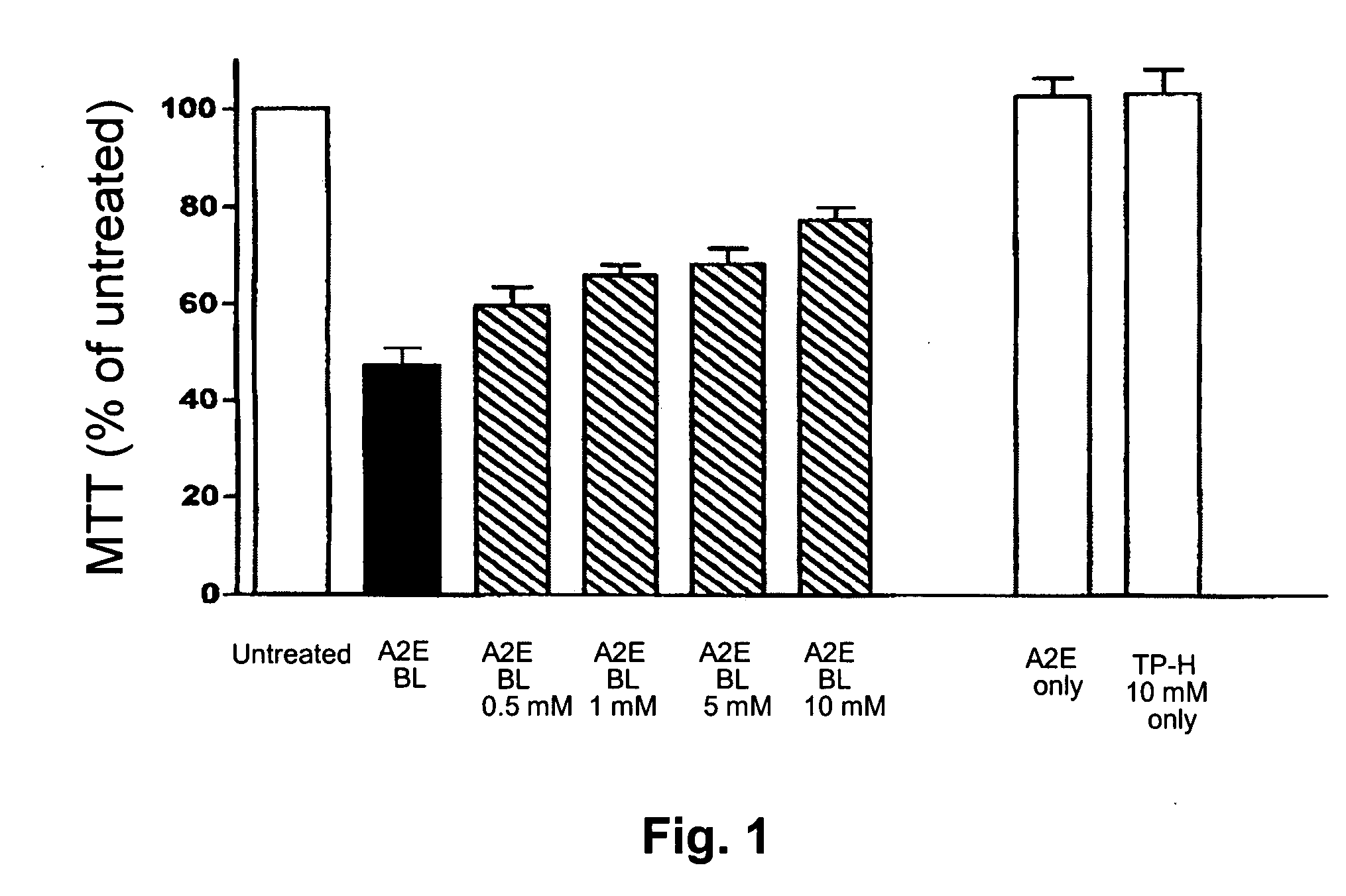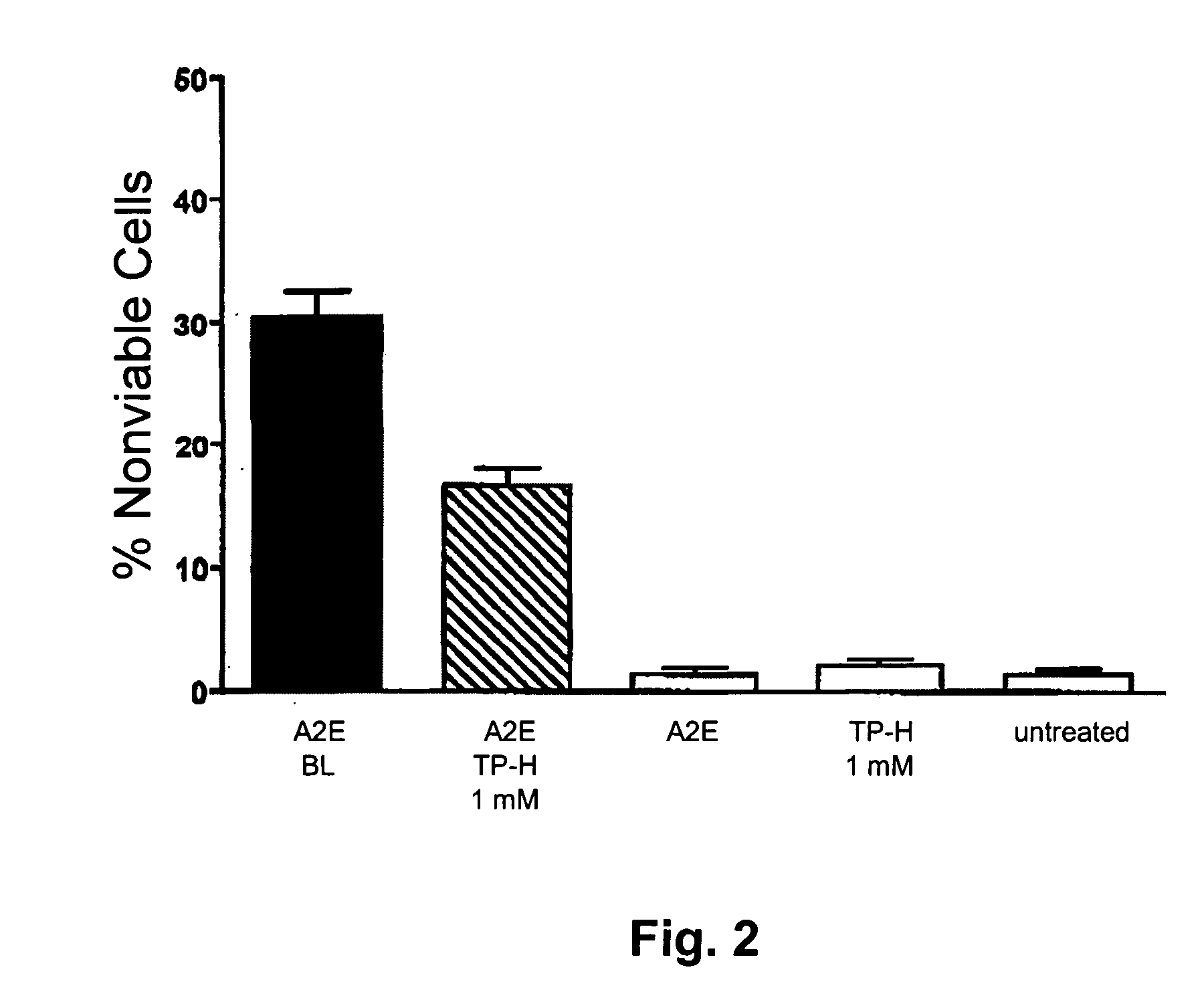Amelioration of macular degeneration and other ophthalmic diseases
a technology for ophthalmology and macular degeneration, applied in the field of ophthalmological diseases, can solve the problems of oxidative tissue damage, depletion of cellular reactive oxygen species (ros), blood and fluid pooling within the layers of the retina, blurred central vision, etc., to prevent/treat damage to rectal tissue, improve the effect of ophthalmological symptoms, delay or prevent the development of ophthalmological symptoms
- Summary
- Abstract
- Description
- Claims
- Application Information
AI Technical Summary
Benefits of technology
Problems solved by technology
Method used
Image
Examples
example 1
Effect of Tempol-H Treatment on Photochemical Retinal Injury in a Rabbit Model
[0072] The ability of light to produce retinal injury well below the levels capable of producing thermal damage has been termed photochemical retinal injury. The mechanism of action for photochemical retinal injury is believed to be the light induced production of free radicals. The ability of commonly used light sources in clinical ophthalmology to produce photochemical retinal injury is well recognized. The operating microscopes used in ophthalmic surgery have been shown to have the capability of producing retinal photochemical injury. This observation has been utilized to produce a model in the rabbit eye to test the ability of various agents to block photochemical retinal injury. It has been determined that opthalmoscopically visible retinal lesions are detectable after as little as 2.5 minutes of exposure to an operating microscope. The protocol set forth below is utilized to determine whether tempol...
example 2
Evaluation of Tempol-H Incorporation into Retinal Tissue of Rabbits Following Intravitreous Injection
[0075] To assess the efficacy of tempol-H at preventing AMD and other retinal disorders, it must be determined that the drug is incorporated into retinal tissue. The protocol set forth in this example utilizes scintillation technique to establish quantity and duration of tempol-H incorporation into retinal tissue following intravitreous injection in the rabbit. The New Zealand White Rabbit is well characterized in experiments involving intravitreous injection as the large eye of the rabbit provides a suitable template for treatment administration (Hosseini et al., 2003, Lasers Surg. Med. 32: 265-270). Furthermore, the New Zealand White Rabbit has been used extensively in experiments assessing drug uptake into retinal tissue via scintillation technique (Ahmed et al., 1987, J. Pharm. Sci. 76: 583-586).
[0076] Materials and Methods: Twenty-four New Zealand White Rabbits, all male, weig...
example 3
Efficacy Tempol-H in Protection Against Photooxidative Processes in the Retinal Pigment Epithelium (RPE)
[0082] Background: Although the etiology of atrophic age-related macular degeneration (AMD) is not fully understood, it is generally accepted that AMD begins with the death of retinal pigment epithelial cells, the degeneration of photoreceptor cells, and resultant loss of vision, occurring thereafter. There is a growing body of evidence linking the lipofuscin that accumulates in RPE with the death of these cells. For instance, not only are lipofuscin levels highest in RPE cells underlying the macula, the monitoring of RPE lipofuscin by detection of fundus autofluorescence has also shown that areas of RPE atrophy develop at sites of previously increased fluorescence. Studies concerned with examining associations between RPE lipofuscin and RPE cell death have shown that a major constituent of RPE lipofuscin, the bisretinoid fluorophore A2E, can perturb cellular membranes and can me...
PUM
| Property | Measurement | Unit |
|---|---|---|
| Molar density | aaaaa | aaaaa |
| Molar density | aaaaa | aaaaa |
| Molar density | aaaaa | aaaaa |
Abstract
Description
Claims
Application Information
 Login to View More
Login to View More - R&D
- Intellectual Property
- Life Sciences
- Materials
- Tech Scout
- Unparalleled Data Quality
- Higher Quality Content
- 60% Fewer Hallucinations
Browse by: Latest US Patents, China's latest patents, Technical Efficacy Thesaurus, Application Domain, Technology Topic, Popular Technical Reports.
© 2025 PatSnap. All rights reserved.Legal|Privacy policy|Modern Slavery Act Transparency Statement|Sitemap|About US| Contact US: help@patsnap.com



